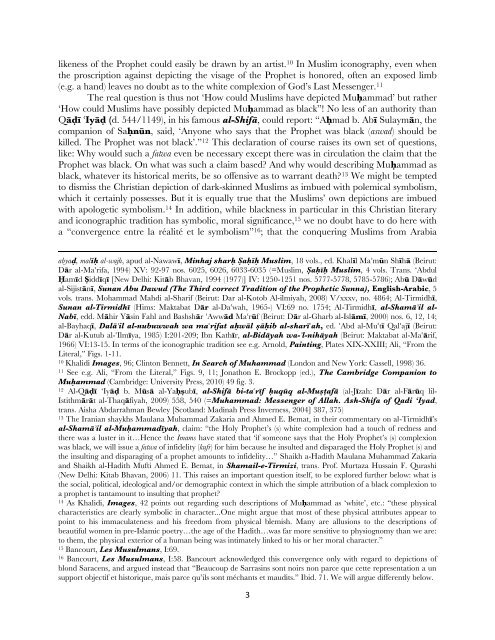Muhammad_Article.349.. - Dr. Wesley Muhammad
Muhammad_Article.349.. - Dr. Wesley Muhammad
Muhammad_Article.349.. - Dr. Wesley Muhammad
You also want an ePaper? Increase the reach of your titles
YUMPU automatically turns print PDFs into web optimized ePapers that Google loves.
likeness of the Prophet could easily be drawn by an artist. 10 In Muslim iconography, even when<br />
the proscription against depicting the visage of the Prophet is honored, often an exposed limb<br />
(e.g. a hand) leaves no doubt as to the white complexion of God’s Last Messenger. 11<br />
The real question is thus not ‘How could Muslims have depicted MuÈammad’ but rather<br />
‘How could Muslims have possibly depicted MuÈammad as black”! No less of an authority than<br />
Q§∙Ê #Iy§∙ (d. 544/1149), in his famous al-Shif§, could report: “AÈmad b. AbÊ Sulaym§n, the<br />
companion of SaÈnån, said, ‘Anyone who says that the Prophet was black (aswad) should be<br />
killed. The Prophet was not black’.” 12 This declaration of course raises its own set of questions,<br />
like: Why would such a fatwa even be necessary except there was in circulation the claim that the<br />
Prophet was black. On what was such a claim based? And why would describing MuÈammad as<br />
black, whatever its historical merits, be so offensive as to warrant death? 13 We might be tempted<br />
to dismiss the Christian depiction of dark-skinned Muslims as imbued with polemical symbolism,<br />
which it certainly possesses. But it is equally true that the Muslims’ own depictions are imbued<br />
with apologetic symbolism. 14 In addition, while blackness in particular in this Christian literary<br />
and iconographic tradition has symbolic, moral significance, 15 we no doubt have to do here with<br />
a “convergence entre la réalité et le symbolism” 16 ; that the conquering Muslims from Arabia<br />
abya∙, malÊÈ al-wajh, apud al-NawawÊ, Minhaj sharÈ ‘aÈÊÈ Muslim, 18 vols., ed. KhalÊl Ma"mån ShÊh§ (Beirut:<br />
D§r al-Ma#rifa, 1994) XV: 92-97 nos. 6025, 6026, 6033-6035 (=Muslim, ‘aÈÊÈ Muslim, 4 vols. Trans. ‘Abdul<br />
\amÊd ‘iddÊqÊ [New Delhi: Kit§b Bhavan, 1994 (1977)] IV: 1250-1251 nos. 5777-5778, 5785-5786); Abå D§wåd<br />
al-Sijist§nÊ, Sunan Abu Dawud (The Third correct Tradition of the Prophetic Sunna), English-Arabic, 5<br />
vols. trans. Mohammad Mahdi al-Sharif (Beirut: Dar al-Kotob Al-ilmiyah, 2008) V/xxxv, no. 4864; Al-TirmidhÊ,<br />
Sunan al-TirmidhÊ (Hims: Maktabat D§r al-Da#wah, 1965-) VI:69 no. 1754; Al-TirmidhÊ, al-Sham§"il al-<br />
NabÊ, edd. M§hir Y§sin Fahl and Bashsh§r #Aww§d Ma#råf (Beirut: D§r al-Gharb al-Isl§mÊ, 2000) nos. 6, 12, 14;<br />
al-BayhaqÊ, Dal§"il al-nubuwwah wa ma#rifat aÈw§l ߧÈib al-sharÊ#ah, ed. #Abd al-Mu#tÊ Qal#ajÊ (Beirut:<br />
D§r al-Kutub al-#IlmÊya, 1985) I:201-209; Ibn KathÊr, al-Bid§yah wa-"l-nih§yah (Beirut: Maktabat al-Ma#§rif,<br />
1966) VI:13-15. In terms of the iconographic tradition see e.g. Arnold, Painting, Plates XIX-XXIII; Ali, “From the<br />
Literal,” Figs. 1-11.<br />
10 Khalidi Images, 96; Clinton Bennett, In Search of <strong>Muhammad</strong> (London and New York: Cassell, 1998) 36.<br />
11 See e.g. Ali, “From the Literal,” Figs. 9, 11; Jonathon E. Brockopp (ed.), The Cambridge Companion to<br />
MuÈammad (Cambridge: University Press, 2010) 49 fig. 3.<br />
12 Al-Q§∙Ê ‘Iy§∙ b. Mås§ al-YaÈßubÊ, al-Shif§ bi-ta#rÊf Èuqåq al-Mußãaf§ (al-JÊzah: D§r al-F§råq lil-<br />
Istithm§r§t al-Thaq§fiyah, 2009) 558, 540 (=<strong>Muhammad</strong>: Messenger of Allah. Ash-Shifa of Qadi ‘Iyad,<br />
trans. Aisha Abdarrahman Bewley [Scotland: Madinah Press Inverness, 2004] 387, 375)<br />
13 The Iranian shaykhs Maulana <strong>Muhammad</strong> Zakaria and Ahmed E. Bemat, in their commentary on al-TirmidhÊ’s<br />
al-Sham§"il al-MuÈammadÊyah, claim: “the Holy Prophet’s (s) white complexion had a touch of redness and<br />
there was a luster in it…Hence the Imams have stated that ‘if someone says that the Holy Prophet’s (s) complexion<br />
was black, we will issue a fatwa of infidelity (kufr) for him because he insulted and disparaged the Holy Prophet (s) and<br />
the insulting and disparaging of a prophet amounts to infidelity…” Shaikh a-Hadith Maulana <strong>Muhammad</strong> Zakaria<br />
and Shaikh al-Hadith Mufti Ahmed E. Bemat, in Shamail-e-Tirmizi, trans. Prof. Murtaza Hussain F. Qurashi<br />
(New Delhi: Kitab Bhavan, 2006) 11. This raises an important question itself, to be explored further below: what is<br />
the social, political, ideological and/or demographic context in which the simple attribution of a black complexion to<br />
a prophet is tantamount to insulting that prophet?<br />
14 As Khalidi, Images, 42 points out regarding such descriptions of MuÈammad as ‘white’, etc.: “these physical<br />
characteristics are clearly symbolic in character...One might argue that most of these physical attributes appear to<br />
point to his immaculateness and his freedom from physical blemish. Many are allusions to the descriptions of<br />
beautiful women in pre-Islamic poetry…the age of the Hadith…was far more sensitive to physiognomy than we are:<br />
to them, the physical exterior of a human being was intimately linked to his or her moral character.”<br />
15 Bancourt, Les Musulmans, I:69.<br />
16 Bancourt, Les Musulmans, I:58. Bancourt acknowledged this convergence only with regard to depictions of<br />
blond Saracens, and argued instead that “Beaucoup de Sarrasins sont noirs non parce que cette representation a un<br />
support objectif et historique, mais parce qu’ils sont méchants et maudits.” Ibid. 71. We will argue differently below.<br />
3

















